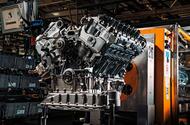Production of the marque's 12-cylinder engine has come to an end - we explain how Crewe made it so smooth
One chapter in the story of our love affair with 12-cylinder engines has come to an end with news that Bentley has finally ceased W12 production.
Despite this engine being hand-built from 2600 parts, each example was finished fairly quickly – in seven hours.Â
Once installed and fired up, the 6.0-litre, twin-turbocharged giant was capable of powering a Continental GT to a staggering 208mph.
It had been redeveloped over a three-year period for the introduction of the Bentayga in 2015, with faster-responding twin scroll turbos and cylinder deactivation on one bank of six to reduce consumption when the driver lifts or trails the throttle. For its first use in an SUV, it was also tested to perform at tilt angles of up to 35deg.
Affection for 12-cylinder engines has endured with good reason. Many car makers have chosen V12s for refinement and power, and Crewe chose the same route but with a W12, which is a close relative with one subtle but important tweak.
Before we get to that, what are the qualities that have made V12s so desirable and enduring for almost the entire history of the combustion engine, and why have them?Â
An engine’s smoothness is decided by how little it vibrates. Two of the most important things deciding that are primary balance (vibrations that occur at every revolution of the engine) and secondary balance (every two revolutions).Â
Things that cause those vibrations are reciprocating masses (the weight of internal parts moving vertically or horizontally) and rotating masses, such as the crankshaft and combustion forces each time a cylinder fires. There are lots of other factors that also affect balance, including the cylinder firing order and whether individual reciprocating parts like pistons and conrods all weigh precisely the same.
Straight-six engines have perfect balance, largely because the number of cylinders allows movement of the pistons to be perfectly orchestrated. So it follows that a V12 with two banks of six cylinders should be in perfect balance as well, and it is. The W12 follows suit but is so - called because, like Volkswagen’s old VR6, the cylinders in each bank are offset by 15deg so that they can be closer together, making the engine 24% shorter.Â
But it still only has two banks of cylinders, like a conventional V12, even though the name suggests it might have four to form a more literal W shape. Like a V12, the W12 is also smooth as silk, passing the ‘coin test ’, where a coin can stand unaided on its surface at idle.Â
It owes at least part of that refinement to the hand-building as well as good genes, with pistons and conrods being sorted into balanced sets weighing within fractions of a gram.

